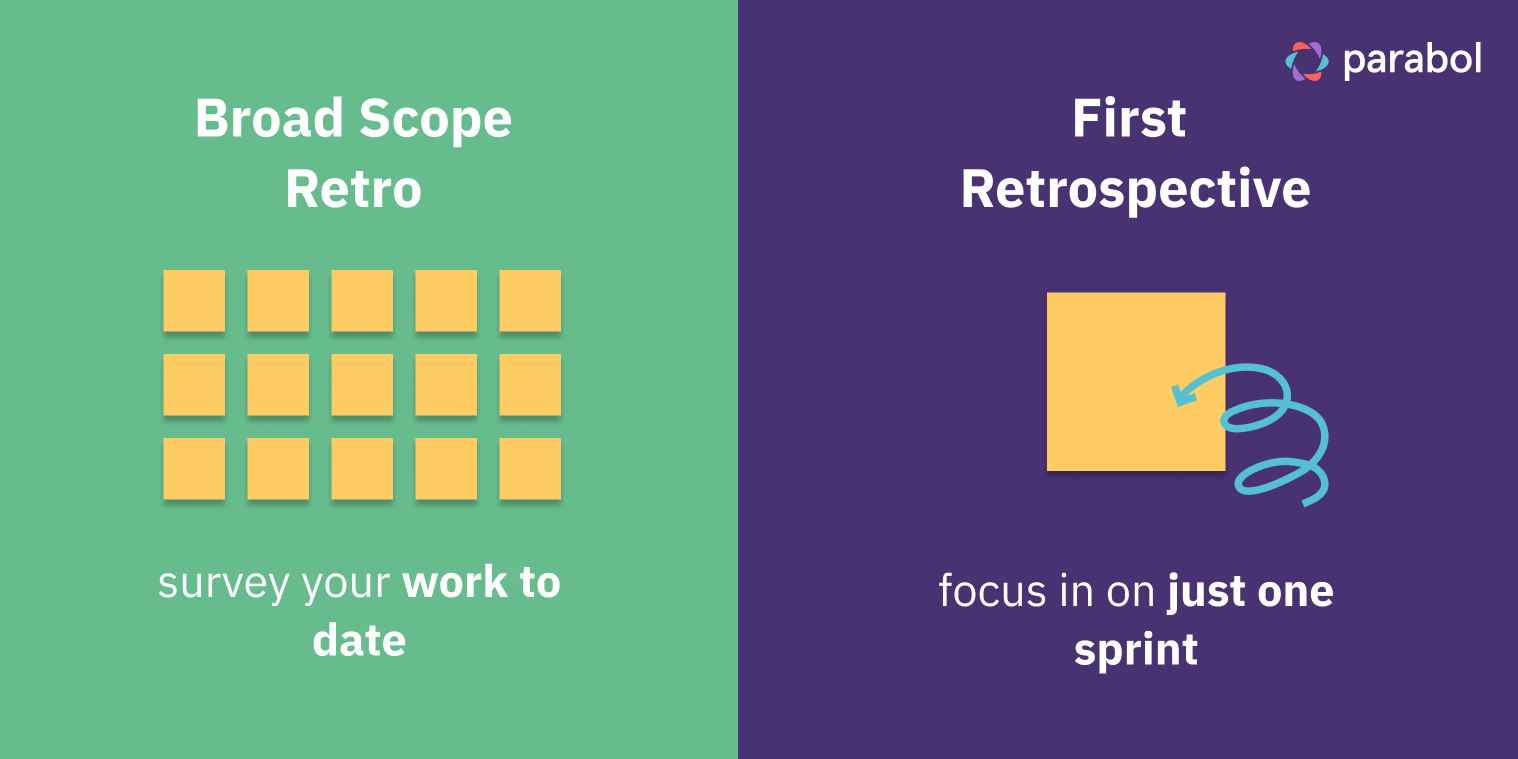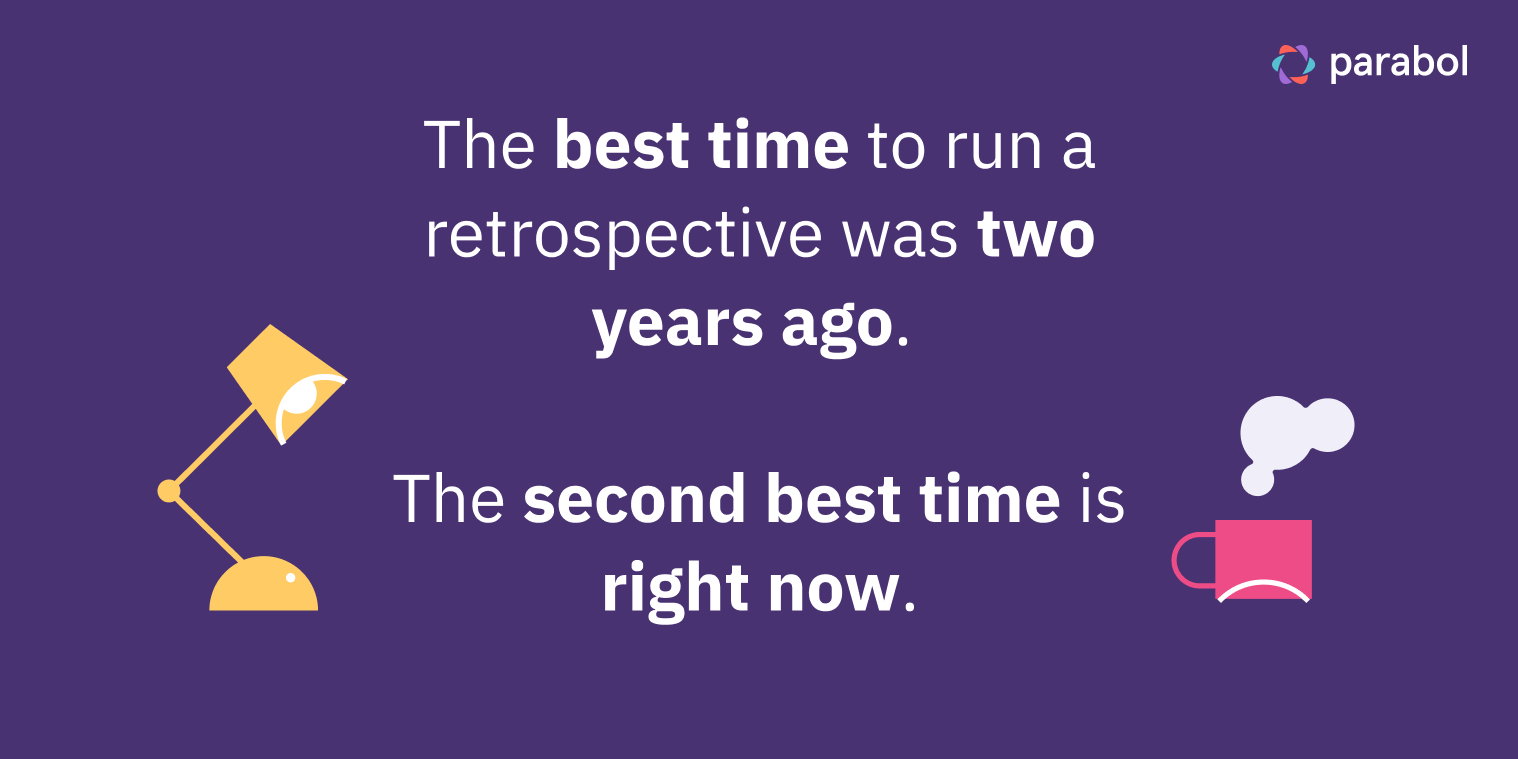How to Kick-Start a Habit of Regular Retrospectives

Agile teams around the world understand how quickly small incremental changes every sprint can add up to huge improvements in team performance.
So how can you benefit from a habit of continuous improvement if you haven’t run a retrospective in a long time, or you’ve never done one before?
Getting started can feel daunting, especially since each retrospective meeting is meant to build on the last one. But retrospectives are an ongoing process, even for experienced teams. You can’t solve everything in one meeting, so don’t try to.
In this guide, we’re covering how to build a habit of running sprint retrospectives:
In an ideal world, teams should conduct retrospective meetings after every sprint. However, there are a few reasons why you might not have done one for a while or at all!:
- 🐣 The team is new to agile: If you’re in the midst of an agile transformation, you may have never hosted a retrospective before but want to get started making continuous improvements.
- 🆕 New teams have formed: You could have a newly-formed team of people who have never run a retrospective together, even if they’re familiar with the process from working in other teams. .
- 👑 Leadership changes: Product, engineering, organizational or even leadership, changes can freeze retrospectives as teams focus on adapting to change.
- ❄️ Extended cool-off periods: Retrospectives can be heated and a facilitator may skip one or two to let the team cool-off. Unfortunately, this can become a habit and before you know it, your team doesn’t do retrospectives anymore.
- 😬 There’s no team ownership of the retrospective: If you over-rely on one person to manually book sprint milestones like retrospectives, it’s easy for things to get lost if that person is out of the office or gets pulled into other tasks.
- 💣 Sprints got destroyed: If emergencies keep impacting a sprint, the product owner might choose not to host a retrospective to save more time to deal with emergencies. If that keeps happening, you end up devaluing the retrospective and can build a habit of skipping them when something comes up.
- 😔 Negative repercussions left a sour taste in everyone’s mouth: Sometimes people attend retrospectives who shouldn’t be present. This leaves room for misinterpretation and misunderstanding from that person, which can turn a team off from doing retrospectives in general.
When to kick-start your retrospectives
Whether you’re starting out or getting back into the rhythm of doing sprint retrospectives, take a page from change management principles.
Try to introduce retrospectives into your working rhythm when there’s already change underway. This makes a regular cadence of retrospectives part of the “new normal” and helps the habit stick.
You can also make the end of the next sprint your “change point”, to anchor it, but try to link it up with other changes if possible so there’s already momentum on the team.
Examples include:
- 👋 A new team member joined the team.
- 🤖 You’ve started to build a new product/started a new project.
- 👑 Significant leadership changes.
Overall changes make it easy to push a new idea forward, but there’s no sense in artificially holding off in the absence of one.
Sometimes starting retrospectives when things aren’t so busy can feel less stressful and make it easier for a team to give retrospectives the time and attention they deserve.
What your first two retrospectives should look like
Instead of jumping into a classic retrospective process right off the bat, get started by doing a broader post-mortem to deal with any existing baggage or improvements. We recommend doing to retros to kickstart your process:
- 🔭 Broad scope retrospective: This retrospective deals with reflections on work together up to that point so you can clear out any baggage or existing improvements the team can identify. Think of it more like a post-mortem meeting.
- 🔍 First retrospective: This retrospective will be your first proper retrospective focusing on the sprint period in question.

1. 🔭 Broad scope retrospective
Think of the backlog retrospective like your time to “train” everyone on how to participate in retrospectives and identify immediate improvements that may have been swept under the rug when there were no retrospectives at all.
Host this meeting at the end of the sprint where you’ve chosen to launch (or relaunch) regular retrospectives. Go through the mechanics of a retrospective, explain the process, and explain some participant tips so everyone’s ready to bring their A-game. You could also review some pro-tips for retrospective facilitators, too, if you’re feeling a bit rusty, or let us help you out with a failsafe way of running retrospectives.
Use this retrospective more like a post-mortem where you talk through how work is going in general over a longer period of time. What big things are working, and what big things aren’t? You might also want to cover how people feel about their work. The goal of this meeting is to make quick wins and deal with any baggage the team is holding onto.
You can also use this retro to go back further to discuss past projects, again only with an eye to what worked and what didn’t. If you’re looking into the past, you might want to restrict it to just the last quarter because people’s memories can fade and things change rapidly. Anything farther back than three months might not be very relevant for you moving forward.
2. 🔍 First retrospective
Host this meeting at the end of the next sprint (after the one where you run a backlog retrospective). Send the calendar invite for this meeting as soon as the sprint begins. That way, you set a precedent for creating a regular retrospective habit.
Type of retrospective
- Sprint 1: Broad scope retrospective, a bit like a post-mortem: Look back over a longer scope and deal with general improvements.
- Sprint 2: First “official” retrospective: Look back over the last sprint and identify improvements.
- Sprint 3 onwards: Ongoing, regular retrospectives: Look back over the last sprint and identify improvements.
How to get into the habit of regular retrospective meetings
Once you’ve hosted a broad scope retro and your first official retro, it’s time to make the habit continuous. Here are some tips we find helpful for making sure your retrospective habit sticks!
After the first official retrospective:
- 📝 Make sure all action items from your retrospective are documented, so everyone can see what needs to be done. You could do this in Jira, GitHub, or create action items directly in your Parabol retrospective and push tasks out to Jira and GitHub.
- 📆 Send a recurring calendar invite for future retrospectives (match the cadence to your sprint length).
- ⭐ Make the retrospective a ‘sacred’ meeting that cannot be skipped, cancelled, or moved. Reiterate that retrospectives serve the team and the practice should be collectively owned by the team, not the Scrum Master or Product Owner.
These practices help with the concept of habit stacking, where you commit to one task then ‘stack’ it automatically with something else.
Since sprint retrospectives are designed to be done at the end of each sprint, if you book the meeting automatically, you are creating a habit stack where you complete a sprint then immediately do a retrospective.
Treat this time as sacred, and eventually it becomes an ingrained habit that the team does without thinking.
Some other pointers for future retrospectives:
- 🧠 Focus on building a psychologically safe space where people are free to bring up genuine concerns and are unafraid to admit mistakes.
- 🙋 Be clear on who should attend your retrospectives, and who shouldn’t.
- 🕹️ Try gamifying parts of the retrospective to make it more fun.
- 🧩 Try different remote retrospective facilitation techniques to find what works for your team.
A big part of habit formation is automation and consistency.
If you make booking seamless and easy (with recurring calendar invites) and follow through consistently on sharing action items, you’re well on your way to a strong retrospective habit.
In Parabol, you can set up your retro board as soon as you’ve finished your last one. That way, teams can contribute reflections asynchronously throughout the sprint.
How leaders can reinforce habits
Leaders play a significant role in adjusting behavior towards the retrospective process. The biggest piece of this is reiterating and reminding team members that the purpose of the retrospective is to address team collaboration challenges.
So if you had a culture of people bringing up these issues ad-hoc throughout a sprint, tell team members to write down their questions or concerns for the retrospective.
You can encourage the team to do this asynchronously, which will make your retrospectives more time zone friendly and avoid recency bias – where you prioritize the most recent challenge instead of taking a bigger picture view of what’s important for the whole team.
This kind of reinforcement has two further benefits:
- It encourages people to think critically about their needs and what issues they need to bring up in the retrospective
- It applies significance to the retrospective, which helps people take it seriously and engage in the meeting.
Tips to help you kickstart and sustain your retrospective habit
If your team isn’t responding to the traditional structure of a retrospective, here are a few things to try:
- ✨ Revamp the way you run retrospectives: Retrospectives are all about finding ways for the team to collaborate better, and that can happen in a lot of ways. Try novel approaches to running retrospectives to get your team engaged or run a retrospective of your retrospectives to figure out what should change.
- 💡 Encourage team members to try their new ideas by themselves: A retrospective can fall flat when the leader does everything. Offer your team some participant pro-tips so they can try new things on their own and build team ownership of the retrospective process, by rotating facilitators or giving everyone a role.
Retrospectives that help your team evolve

Retrospectives help people come together and honestly discuss the good and the bad of working with each other. Each time teams invest in this process, they form stronger bonds as humans and as a team.
Teams that run regular retrospectives are more resilient, adaptive, and tend to have more psychological safety. And because retrospectives compound on one another, each meeting provides more benefit than the previous one.
If you haven’t done a retrospective in a while – or ever – it’s easy to get the habit started. While you can’t expect a miracle after just one meeting, you’ll start to see improvements quickly.
As the famous Chinese proverb goes:
The best time to plant a tree was a thousand years ago. The second best time is right now.
So what are you waiting for?
To get started quickly, try Parabol for your first (or your next) retrospective!








